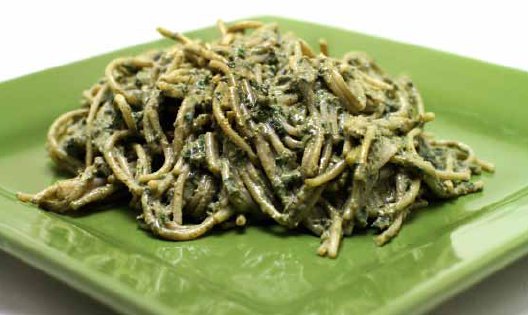Food Over Medicine (19 page)
Read Food Over Medicine Online
Authors: Pamela A. Popper,Glen Merzer

SERVES 4 TO 6
12 cloves garlic, minced
¼ cup fresh ginger, minced
1 jalapeño pepper, minced
1 tablespoon ground ginger
½ tablespoon cayenne pepper
½ cup Bragg Liquid Aminos
2 tablespoons red wine vinegar
¼ cup plus 2 tablespoons cane sugar
¾ cup water
1 cup peanut butter
1 pound linguine, cooked according to package instructions
½ bunch green onions, thinly sliced
1 medium cucumber, halved, seeded, and thinly sliced
For the peanut sauce, combine the garlic, ginger, jalapeño pepper, ground ginger, cayenne pepper, Bragg Liquid Aminos, vinegar, sugar, and water in a large pot; bring the mixture to a boil. Let cook one minute and remove the pot from heat. Add the peanut butter and whisk to combine well.
While the sauce is cooking, prepare the pasta.
Drain the pasta and add it to a bowl with the sauce. Mix well. Serve garnished with green onions and cucumber slices.
MAKES ONE 12-INCH PIZZA
One prebaked, 12-inch whole grain pizza crust
½ cup peanut sauce (see Spicy Thai Peanut Noodles)
1 cup snow peas, sliced on a diagonal
1 cup green onion, sliced
1 medium tomato, diced
1 cup mung bean sprouts
¼ cup toasted peanuts
½ cup basil, chopped
Preheat the oven to 375 degrees.
Spread the peanut sauce over the crust and top with snow peas, green onion, and tomato. Place the pizza on a baking sheet and cook for 12 to 13 minutes. Remove from the oven and top with the sprouts, basil, and peanuts.
MAKES ONE 12-INCH PIZZA
One prebaked, 12-inch whole grain pizza crust
½ cup tomato sauce, more or less to taste
½ green bell pepper, diced
1 cup mushrooms, sliced
½ cup red onion, diced
½ batch oven-fried tofu (use recipe for Barbecue Tofu, without sauce)
Fresh basil for garnish
Preheat the oven to 375 degrees.
Place the pizza crust on a baking sheet and spread the tomato sauce over it. Top with the remaining ingredients and bake for 13 to 14 minutes. Garnish with the fresh basil.



SERVES 4 TO 6
1 pound whole grain linguine
1 cup Creamy Basil Pesto, recipe follows
Cook the pasta according to package instructions, then drain it, reserving one-fourth cup of the liquid.
Add the cooked pasta and pesto to a large bowl and mix well.
2 cups fresh basil leaves, packed
½ package silken tofu
¼ cup nutritional yeast
¼ cup walnuts, toasted
2 cloves garlic, chopped
Sea salt and black pepper to taste
Combine everything in the bowl of a food processor and puree until smooth and creamy.

SERVES 4
2 acorn squash, halved and seeded
Sea salt to taste
1½ cups vegetable broth
¾ cup quinoa, rinsed and drained
1 medium onion, diced small
1 stalk celery, diced small
1 medium carrot, diced small
2 cloves garlic, minced
1 teaspoon fresh thyme, minced
1 teaspoon sage, minced
Salt and black pepper to taste
¾ cup pecans, toasted 7 to 8 minutes in a 350-degree oven
Preheat oven to 350 degrees.
Cut both acorn squash in half crosswise; remove seeds and fibers. Sprinkle salt over cut halves. Place halves in a shallow nonstick baking pan. Add one cup water to the pan. Bake for about 40 minutes, or until tender.
While the squash bakes, prepare the stuffing.
In heavy saucepan, bring broth to a boil. Add the quinoa and cover the pan. Bring it to a boil over high heat and then reduce heat to medium low. Let simmer for 20 minutes, or until the quinoa is tender.
Sauté the onion, celery, and carrot for seven minutes over medium heat. Add the garlic, thyme, sage, salt, and pepper; cook another minute. Remove from heat; fold in the pecans and cooked quinoa.
Spoon the quinoa mixture into the baked squash. Cover with foil, return to the oven, and bake another 20 minutes.
SERVES 1
2 whole bananas, peeled, sliced, and frozen
¼ cup unsweetened almond milk
¼ teaspoon vanilla extract
1 packet stevia or more to taste
Combine all ingredients in a food processor or blender with a powerful motor, and process until the ice cream is smooth and creamy.

SERVES 6 TO 8
9 cups (about 2 pounds) pears, cored, peeled, and sliced
¼ cup organic cane sugar
2 tablespoons fresh lemon juice
1 teaspoon cinnamon
¼ teaspoon nutmeg
1 cup rolled oats, regular or quick-cooking
½ cup whole wheat pastry flour
½ cup organic cane sugar
1 teaspoon cinnamon
¼ cup plus 2 tablespoons unsweetened applesauce
Preheat the oven to 350 degrees.
In a large bowl, combine the pears, sugar, lemon juice, one teaspoon cinnamon, and nutmeg. Mix well and transfer the mixture into a 9x13-inch nonstick baking dish.
In a medium bowl, combine the oats, flour, sugar, and one teaspoon cinnamon. Add the applesauce and mix well.
Sprinkle topping over pear mixture. Bake for 50 minutes, or until topping is nicely browned on top.

THE DIETARY ESTABLISHMENT
....................................
GM:
Pam, I just went on the website of the Academy of Nutrition and Dietetics (AND). I clicked on “nutrition for growing bodies” and saw that they recommend whole grains, fruits, and veggies, including 100 percent juice, low-fat dairy foods, and then a protein group that is lean meat, poultry, fish, eggs, beans, and nuts.
PP:
Right. Hey, it’s the dietary recommendations of the United States Department of Agriculture (USDA). If the USDA issued recommendations tomorrow for everyone to drink ten ounces of arsenic before breakfast, it’d be posted on AND’s website by noon.
GM:
Ha!
PP:
I’m not kidding! And this stuff is important because these are the people providing the dietary guidelines that are being used to design school lunches.
GM:
I read in the
New York Times
about a study that showed that children who eat school lunches are 29 percent more likely to be obese than kids who bring their own lunches to school.
1
PP:
And since their own lunches probably aren’t so great, that gives you an idea of just how awful the school lunches are. The Physicians Committee for Responsible Medicine (PCRM) filed a lawsuit against the USDA over the latest dietary guidelines because they’re so horrific. Not only does AND not say that the guidelines are terrible but its president issued a press release gushing about what a great job the USDA committee did and how hard it worked to sort through all this science to come up with this wonderful recommendation. The president also reminded us, by the way, that AND is the group of people you want to look to for dietary information.
2
It’s almost like the USDA has put AND on the payroll, which wouldn’t be surprising because everyone else has. If the USDA isn’t paying AND, then that would be the one group that has somehow been exempted.
GM:
What do you mean by that? Who’s paying AND?
PP:
They’re heavily funded by sponsors. Millions of dollars a year.
GM:
The dairy industry?
PP:
Oh, there aren’t any that are missed. The dairy industry, the beef industry, food manufacturers like Wrigley and Hershey’s and Kellogg’s—there’s no discernment. If you own a food company and you want to sponsor AND, just step up to the plate with your wallet open. There’s no filtering that says you have to qualify based on promoting a healthful food.
3
So the American Distillers Association, the lamb industry, there’s nobody exempt from their endorsement, provided they show up with a check.
GM:
Is there no group of critics within AND, no group of dietitians, that fights this system and calls it corrupt?
PP:
Not within AND. You have the same thing going on with dietitians that you have going on with medical doctors. When we talk about how bad health care is and how corrupt the medical system is, it all starts with corrupt professional organizations. Just as Dr. John McDougall is not representative of the medical profession, there are great dietitians out there, some of whom are close friends of mine, who have gone to dietetics school and held their noses in order to get their degrees. They’ve reengineered themselves to practice completely differently, to oppose within their own practice the guidelines of their umbrella organization. But there’s no force within AND that is trying to change the system. Of course, AND’s public stance is that it can’t function without this type of money. How would the organization operate, after all? Of course, my response is that we’ve found a way to operate here and not take money from any corporate sponsors. If AND sends representatives, I’ll show them how to do it with something interesting called earned income.
GM:
Why couldn’t AND function just on the dues of practicing members, rather than funds from corporate sponsors?
PP:
Or selling services. There’s no reason why AND couldn’t actually market services in some ways directly to the public, but it’s easier just to take the corporate bucks. I don’t mean to pick on AND, because the American Academy of Pediatrics, the American Medical Association (AMA), and the American Diabetes Association (ADA) all do it. They’re all on the take. They’re
all
taking money. It’s pervasive in the health care business. So we have terrible recommendations that come from the federal government, and all of these organizations are corrupted by the same monetary influence.
GM:
Who gives money, for example, to the AMA?
PP:
The drug industry, mainly in the form of advertising in its journal. The American Psychiatric Association sends its journal free to its members. Guess how it gets to do that? Drug ads. Most of what psychiatrists are seeing is material promoted by the drug companies. I’d like to think that the average psychiatrist is smart enough to know that. Are they smart enough to say, “Maybe I should automatically be skeptical of anything these ads say that are printed in these journals?” I don’t know. Psychiatrists are pretty drug-happy these days.
GM:
Who gives money to the ADA?
PP:
Well, the “health tip of the day” on the website was sponsored by Eskimo Pie for about eighteen months. Because if you’re diabetic, you can never get enough Eskimo Pie.
The artificial sweetener companies contribute a lot. Cadbury Schweppes gave the ADA $1.5 million a few years ago. Cadbury is the third-largest maker of soft drinks in the world and also makes those crème eggs available at Easter. Those are some great items for diabetics also!
GM:
Let me try to wrap my head around this. You’re a manufacturer of soft drinks and you say, “Uh-oh, millions of people in America have become diabetic. That’s not good for us because, after all, we’re selling flavored sugar water. Here’s an idea. Let’s give money to the American Diabetes Association so that doctors won’t tell their patients that soft drinks are bad for them?” Is that really conceivable?
PP:
Well, they basically want the ADA to make mushy, meaningless pronouncements, which it faithfully does, as does the Academy of Nutrition and Dietetics. The party line that AND proudly announces to the general public is that there is room for everything in a healthy diet; that everything in moderation is fine; that there aren’t any good and bad foods; that there aren’t any good and bad dietary patterns; and that different things are appropriate for different people. And essentially it promotes this whole idea that sure, you can go ahead and have that soft drink with that Eskimo Pie.
I did a television interview recently in which this was a big topic of conversation. The promotion of this idea that you can just eat whatever you want without consequences. “You maybe want to do a little less of that and a little bit more of this, but nothing you eat is clearly right or wrong.” You’ll see a lot of statements from the American Diabetes Association, for example, to the effect that it’s important to look at the whole range of products available to diabetics. Look at all the sugar-free drink products you can have, for example, if you’re a little more sugar sensitive than somebody else. And the beverage industry is doing a great job by developing artificially sweetened soft drinks so that diabetics can enjoy these products, too. Yay! Now, of course, my employees here at The Wellness Forum joke that they’ve got guaranteed lifetime employment as long as this nonsense is going on, but I don’t really think that’s our objective here. I’d be happy to find something else to do with myself if we could fix the country’s health problems.
GM:
Let’s talk about AND’s recommendation to eat lean meat and poultry and fish and eggs. What is AND’s factual basis for this? I know that you make your dietary recommendations based on science. Maybe it’s asking too much to expect AND to do the same, but is there any medical literature anywhere that suggests that there’s anything healthy about poultry? Has there ever been a study done that if you eat poultry, it’s good for any of your organs or has a positive effect on longevity? Is there any study in the world that suggests that poultry has health benefits?
PP:
No.
GM:
So no study has ever been done that eating poultry is any better for you than eating rice or beans or lentils or broccoli?
PP:
No. We have studies that show the contrary.
4
First, chicken contains just about as much fat as beef. Even chicken breast with the skin removed, and is broiled rather than fried, derives 23 percent of its calories from fat. And four ounces of chicken contains almost one hundred milligrams of cholesterol, about the same as four ounces of beef. And a study conducted by the Physicians Committee for Responsible Medicine determined that almost half of chicken sold in grocery stores was contaminated with feces.
5
Yet Americans have been told that chicken is better for them than beef and pork. This has caused chicken consumption to more than quadruple between 1950 and 2007, while beef consumption increased by only 50 percent and pork consumption went down.
6
Of course, Americans have continued to get fatter and sicker all the time.
GM:
Well, is there any study that makes any positive case at all for poultry? Is there any study that shows that eating poultry is at least better for you than eating lizards, horses, chipmunks, or rats?
PP:
No.
GM:
So they’re just pulling these recommendations out of their ass?
PP:
They would clearly recommend the nutritional benefits of eating rats if there were a rat farm lobby or if people found fried rats delicious and there was a chain of Kentucky Fried Rat restaurants.
GM:
Is it fair to say that a group like AND will promote some information occasionally that’s based on science, and then other information—like advising people to eat lean meat and fish and eggs and poultry—that’s just a safe way of endorsing the status quo, affirming the general culture and the standard American diet, without any science involved at all so as not to ruffle any feathers in, say, the poultry industry?
PP:
Yes. And what makes this confusing to the general public is that people get on the AND website and, first of all, they have no idea how dietitians are trained and they assume the best. Then they see messages that are clearly right: eat more fruits and vegetables. I mean, who really disagrees with that? Whole grains and beans are good for you. So they see some things that are right and it makes them think this organization is probably right across the board. Even when there’s clearly a sponsorship relationship, such as in the position papers. (It’s printed in very small type in the website’s right-hand corner.) I doubt the average person knows that the paper was written specifically in response to sponsorship money. The Wrigley Science Foundation sponsored a piece that stated you could add enamel to your teeth by chewing gum. Now, I have a lot of friends who are dentists and I’ve asked all of them, “What do you think of this?” They laugh out loud and say, “Who gave you that crazy idea?” Well, it was posted on AND’s website.
The average person can’t be expected to factor in the conflicts of interest. All the average person sees is that these organizations appear to be authoritative and the experts in the field. If you know no more than that, following their advice seems like the sensible thing to do.
GM:
How about the governmental organizations? Do you feel the same way about the Food and Drug Administration (FDA) as you feel about these medical associations?
PP:
Oh, it’s probably worse.
GM:
Then let’s talk about the FDA.
PP:
There are a few different issues to discuss: drug approval and regulation, and regulation of supplements, fortified foods, and the functional foods industry. In terms of the FDA’s drug regulation, the flaw is that the drug companies make a lot of the decisions about study design, even about what’s considered a side effect; they negotiate with the FDA on what should be listed as a side effect.
GM:
How do you negotiate on what should be listed as a side effect?
PP:
Well, Prozac doesn’t list withdrawal symptoms as a side effect because both the manufacturer and the FDA agreed that if the list of side effects was too long, it would discourage people from taking the drug.
7
GM:
I’m always amazed by the TV commercials for drugs. They might be for restless leg syndrome or erectile dysfunction or something and they say, “May cause headaches, fatigue, nausea, diarrhea, dizziness, suicidal thoughts, stroke, heart failure, kidney failure, unusual bleeding, or sudden death.” And I’m thinking, how badly do you want to keep your appendages in a certain position? I mean, after hearing these warnings, who the hell is buying these things?
PP:
Well, the drug ads work because there are plenty of people out there who have these conditions. They go in and ask their doctor for the drugs, and the doctors feel as if they should accommodate their patients. What they should really do is say no. It’s okay to say no to somebody. Of course, doctors worry that the patient will switch to the doctor down the street. My response would be to let them. Let them go to the doctor down the street and get the bad treatment. You don’t get it here.
